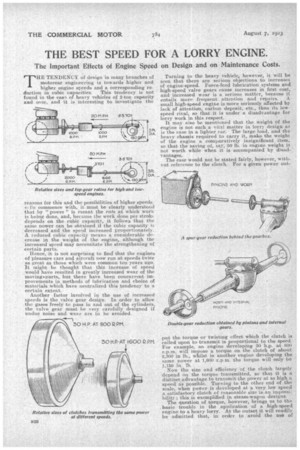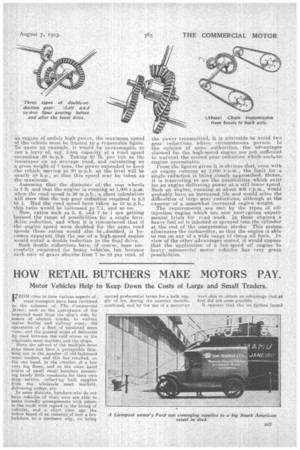THE BEST SPEED FOR A LORRY ENGINE.
Page 10

Page 11

If you've noticed an error in this article please click here to report it so we can fix it.
The Important Effects of Engine Speed on Design and on Maintenance Costs.
THE TENDENCY of design in many branches of motorcar engineering is towards higher and higher engine speeds and a corresponding re. duction in cubic capacities. This tendency is not found in the cas,i of heavy vehicles of 2-ton capacity and over, and it is interesting to investigate the reasons for this and the possibilities of higher speeds. snFo commence -with, it must be clearly understood that by "power " is meant the rate at which work is being done, and, because the work done per stroke dependson the cubic capacity, it follows that the same power can be obtained if the cubic capacity is decreased and the speed increased proportionately. A reduced cubic capacity means a considerable decrease in the weight at the engine' although the increased speed may necessitate the strengthening of certain parts. Hence, it is not surprising to find that the engines of pleasure cars and aircraft now ran at speeds twice as great as those which were common ten years ago. It might be thought that this increase of speed
• ,would have resulted in greatly increased wear of the moving+ parts, but there have been concurrent improvements in methods of lubrication and choice of materials which have neutralized this tendency to a certain extent.
Another factor involved in the use of increased• speeds is the valve gear design. In order to allow the gases freely to pass in and out of the cylinders. the valve gear must be very carefully desig-ned if undue noise and wear are to be avoided.
Turning to the heavy vehicle, however, it will be seen that there are serious objections to increases of •engine-speed. Force-feed lubrication systems and high-speed valve gears cause increases in first cost, and increased wear is a serious matter, because it entails more frequent attention and repairs. A small high-speed engine is more seriously affected by lack of attention, carbon deposit, etc., than its lowspeed rival, so that it is under a disadvantage for lorry work in this respect.
It may also be mentioned that the weight of the engine is not such a vital matter in lorry design a.s 3Ft. is the ease in a lighter car. The large load, and the heavy chassis required to carry it, make the weight of the engine, a comparatively insignificant item, so that the saving of, say:, 50 lb. in engine weight is not worth while when it is accompanied by disadvantages.
The case would not be stated fairly, however, without reference to the clutch. For a given power out
01A.
30 ft P'AT1600 PPM. called upon to transmit is proportional to the speed. For example, an engine developing 20 n.p. at 800 r.p.m. will impose a torque on the clutch of about 2,200 in lb., whilst in another engine developing the same power at 1,600 rpm. the torque will only be 1,150 in. lb.
Now the size and efficiency of the clutch largely depend on the torque transmitted, so that it is a
. distinct ,advantage to transmit the power at as high a, speed as possible. Turning to the other end of the scale; when power is developed at a -very low speed a satisfactory clutch of reasonable size is an iinpossibility; this is exemplified in steam-warn designs. The question of torque, however, brings us to tbo basic trouble in the application of a high-speed engine to a heavy lorry. At the outset it will readily be admitted that, in order to avoid the use of
an engine of unduly high power, the maximum speed of the vehicle must be limited to a reasonable figure.
• To quote an example, it Would be unreasonable to run a lorry of, say, d-ton capacity at a read speed exceeding 20 m.p.h. Taking 80 lb. per ton as the resistance on an average road, and caleulating on a gross weight of 7 tons,, the power expended to keep the vehicle moving at 20 m.p.h. on the level will be nearly :30 h.p., so that this speed may be taken as the maximum.
Assuming that the diameter of the rear wheels is 3 ft. and that the engine is running at 1,000 r.p.m. when the read speed is 20 m.p.h., a short calculation will show that the top gear reduction required is 5.3 to 1. Had the read soeed been taken as 15 m.p.h., -this ratio would be increased to 7.1, and so on.
Now, ratios such as 5, 6, and 7 to 1 are getting beyond the range of possibilities for a single finaldrive reduction, and when it is remembered that if the engine speed were doubled for the same road speeds these ratios would also be .doubled, it becomes apparent that the use of a high-speed engine would entail a double reduction in the final drive. Such double reductions have, of course, been successfully employed for heavy vehicles, but because each nair of gears abserbs from 7 to .10 per cent. of the power transmitted, it is advisable to avoid two gear reductions where circunistances permit. In the opinion of some authorities, the advantages claimed for the high-speed engine are pot sufficient to warrant the second gear redaction which sucluan engine necessitates.
From the figures given it is obvious that, 'even with an engine running at 1,000, r.p.m., the limit for a single reduction is being-. elesely approached. _Hence. it is interesting to see the possibilities which exist for an engine delivering power at a still lower speed. Such an engine, running at about ,600 r.p.m., would probably have an increased life and would solve the difficulties of large gear reductions, although at the expense of a somewhat increasedengire weight.
The -requirements are met by the types of oilinjection engine which are now undergoing experimental trials for road work. In these engine k a heavy fuel oil is injected or sprayed into the cylinder at the end of the compression stroke. This system eliminates the carburetter, so that the engine is able to run on any of a wide range Of cheap oil fuels, In view of the other advantages stated, it would appear that the application of a low-speed oil engine to heavy commercialmotor vehicles has very great possibilities. •




























